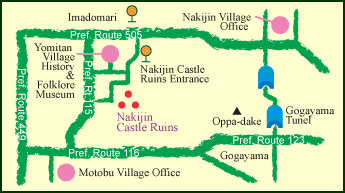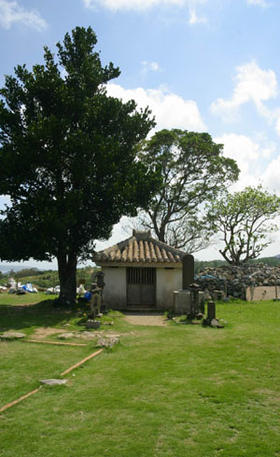Nakijin castle
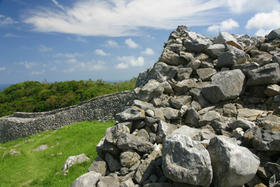 The ruins of Nakijin castle are located in the northern part of Okinawa Island in the Imadomari area of Nakijin Village. At an elevation of 100 meters, it is a mountain castle built on limestone cliffs and was the fortress of the northern Hokuzan kings.
The ruins of Nakijin castle are located in the northern part of Okinawa Island in the Imadomari area of Nakijin Village. At an elevation of 100 meters, it is a mountain castle built on limestone cliffs and was the fortress of the northern Hokuzan kings.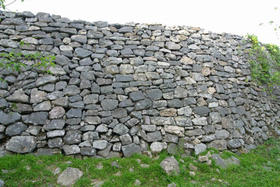
The castle has nine fortified stone walls with a central donjon. The western face of the castle is the main gate, and heading east it gets taller. Passing through Heiro Gate into the second stone enclosure are the remains of the northern headquarters. To the left and right are Umiya gardens and the Uchibaru, and one arrives in a loop at the highest point. The stone enclosure on the east side widens and shortens and is called the "Shikema."
The ramparts are evenly laid Ryukyuan limestone and are piled three meters high at the lowest and eight meters high at the highest place. The total length exceeds 1.5 kilometers. On top of the walls is a further 90-centimeter parapet, 60 centimeters thick, to function as a further layer of defense.
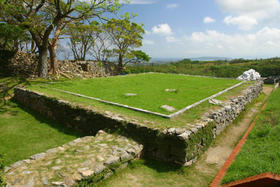 Archeological studies on the stone enclosure called Shikema detected an older structure, and many artifacts were unearthed. Research is progressing on the discovery of the real shape of the ruins of Nakijin Castle
Archeological studies on the stone enclosure called Shikema detected an older structure, and many artifacts were unearthed. Research is progressing on the discovery of the real shape of the ruins of Nakijin Castle
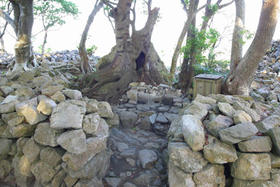 It is believed Nakijin Castle was constructed in the 13th century and was, until the early part of the 14th century, the headquarters of generations of feudal lords called Aji. With the arrival of the Sanzan Period (Three Kingdoms Period), each of the kingdoms was set up to defend its territory. Hokuzan was in the north, Chuzan was in the middle, and Nanzan was in the south. Nakijin Castle became the center of the northern Hokuzan kingdom when a lord named Haniji gained power; he made the existence of Hokuzan known.
It is believed Nakijin Castle was constructed in the 13th century and was, until the early part of the 14th century, the headquarters of generations of feudal lords called Aji. With the arrival of the Sanzan Period (Three Kingdoms Period), each of the kingdoms was set up to defend its territory. Hokuzan was in the north, Chuzan was in the middle, and Nanzan was in the south. Nakijin Castle became the center of the northern Hokuzan kingdom when a lord named Haniji gained power; he made the existence of Hokuzan known.
The Chuzan Kingdom established tributary relations with Ming China in 1383, and Haniji of Hokuzan followed suite, receiving investiture envoys called "Sappo" from China in 1385.
Hokuzan, along with Chuzan and Nanzan, was one of the existing powers. After Haniji, his son Min became king of Hokuzan. King Min was followed by the reign of Hananchi.
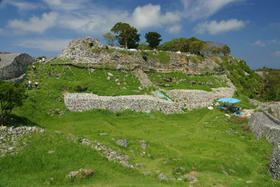 The Sanzan kingdoms looked as if they competed with each other, but records left by the Ming emissary indicate there were differences in strength. For Hokuzan, Haniji sent trade and tribute ships to China six times, his son Min once, and Hananchi eleven times. However, after Sho Hashi took Chuzan Kingdom, trade and tribute ships were sent as often as six times a year. Compared with that, Hananchi averaged only one every two years. In particular, during the nine-year period after 1405 there were no ships sent. In 1415 ships were sent once; until the kingdom was destroyed by Sho Hashi in 1422 there were no more. In comparison with the Chuzan Kingdom, Hokuzan was numerically inferior in overall strength.
The Sanzan kingdoms looked as if they competed with each other, but records left by the Ming emissary indicate there were differences in strength. For Hokuzan, Haniji sent trade and tribute ships to China six times, his son Min once, and Hananchi eleven times. However, after Sho Hashi took Chuzan Kingdom, trade and tribute ships were sent as often as six times a year. Compared with that, Hananchi averaged only one every two years. In particular, during the nine-year period after 1405 there were no ships sent. In 1415 ships were sent once; until the kingdom was destroyed by Sho Hashi in 1422 there were no more. In comparison with the Chuzan Kingdom, Hokuzan was numerically inferior in overall strength.
Sho Shisho had ambition to unify the Ryukyu and, with son Sho Hashi, moved his troops to attack Hokuzan. The pretext for the decision by Sho Shisho and his son to raise an army was that all the Hokuzan local Aji lords had given up because Hananchi of Nakijin Castle was a tyrant and that following Chuzan and its unrivaled power was the wisest policy. Surrendering to Chuzan, they joined with them and plotted to bring down Nakijin Castle. Among the powerful military commanders aiming to defeat Hokuzan with the Sho Hashi forces was the lord of Yuntanza, named Gosamaru.
 |
|  |  |  |
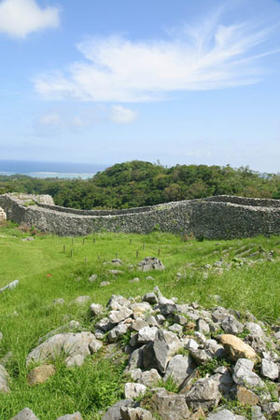 The attacking armies did not find it easy at first to bring down Nakijin Castle, which Hokuzan boasted of as being impregnable. The Chuzan forces devised a plan, a strategy that was to be talked about for a long time thereafter.
The attacking armies did not find it easy at first to bring down Nakijin Castle, which Hokuzan boasted of as being impregnable. The Chuzan forces devised a plan, a strategy that was to be talked about for a long time thereafter.
There was a confidant of Hananchi named Motobu Tehara. The Chuzan won over this confidant and set a trap for Hananchi. Tehara exited the castle and, pretending to have routed the attacking Chuzan, called out to Hananchi. Hananchi, in a show of bravery, led a charge outside, but as he tenaciously pursued the Chuzan armies flames went up at Nakijin Castle. It was too late by the time he noticed Tehara's treachery because the Chuzan armies had already entered and the castle had fallen.
There is an anecdote about the ruins of Nakijin Castle and a person named Shikema Utudaru.
This happened in the age before Haniji ruled Nakijin Castle. A native of Shikema Village, Utudaru was a beautiful young woman. At some point she became the mistress of the lord of Nakijin Castle. For a long time the lord had wanted children, and finally his legal wife gave birth to a child they named Chiyomatsu. At the moment when the lord felt relieved because he had a family heir, there was a revolt by one of his vassals named Motobu Ufunushi. Both the wife and mistress were trying to escape, but without being able to convalesce, the wife realized she could not escape, entrusted Chiyomatsu to the mistress Utudaru and threw herself into the Shikema river. Utudaru raised the boy splendidly. Chiyomatsu reached adulthood and took the name Okaharu and, along with other former vassals, brought down his father's enemy. Motobu Ufunushi Okaharu became the young Aji lord and ruled Nakijin Castle
The person who supported him in his activities was Utudaru, the woman who raised him like her own child. In tribute to her beauty and devoted behavior, the saying "like the mistress of Nakijin" was born. The tomb of Utudaru is located at the foot of the castle ruins facing the cliff on the other side of the Shikema river.
|
|
|
(Kunigami-bu, Nakijin Village) Heritage Site
This was the castle of the king who ruled the northern kingdom - Hokuzan -- during the Three Kingdoms period, directly before the establishment of a unified kingdom in 1429. The three kingdoms were Hokuzan in the north, Chuzan in the central area, and Nanzan in the south. In 1416, Hokuzan was destroyed by Chuzan and it later became the residence of a supervisor called the Hokuzan Kanshu, dispatched by the Ryukyu royal court to watch over the area. It
is a designated historic sight.
|
|
Management / Inquiries
Nakijin Village Board of Education
5110 Imadomari, Nakijin Village, Okinawa 905-0428 Japan
Phon:. (098)056-3201 / 5767
*The ruins of Nakijin Castle Site Management Office
Phone: (098)056-4400
[USE GUIDE]
Hours of Operation: 8:00 AM - 5:00 PM
Open year-round
Admission
| Adult: | 150Yen | (Groups - 120 Yen per person) |
| Senior High School Students: | 100Yen | (Groups - 80 Yen per person) |
| Junior High / Elementary Students: | 50Yen | (Groups - 40 Yen per person) |
Groups: Over 20 persons[Map] 